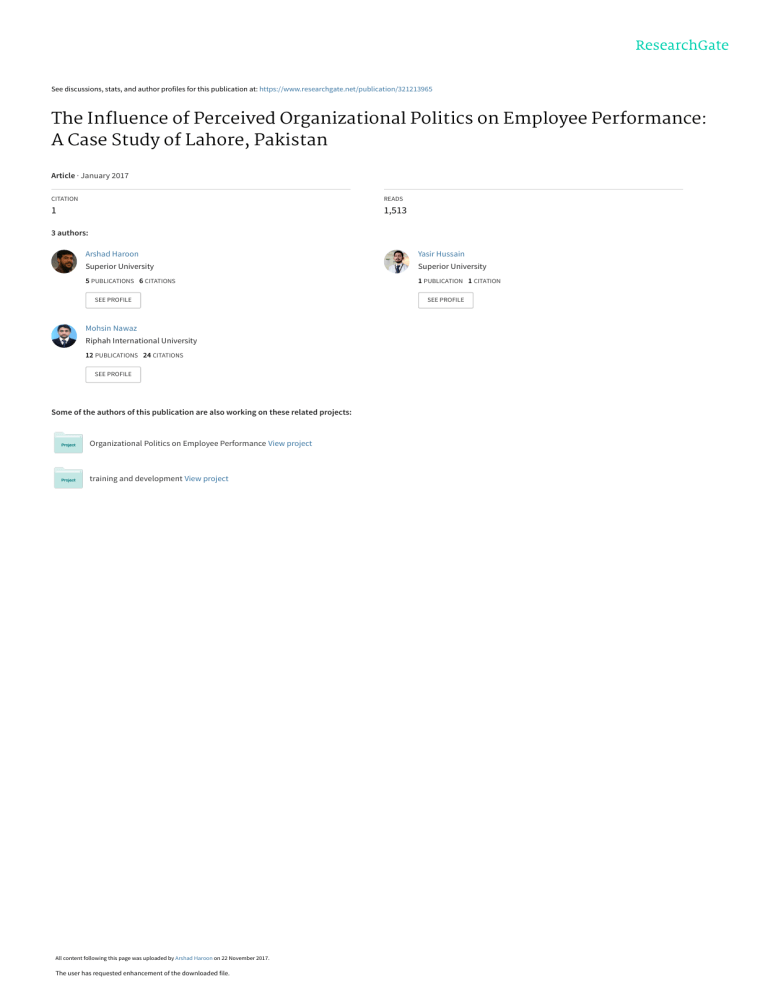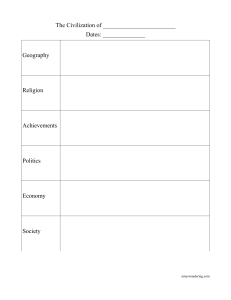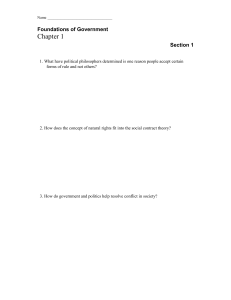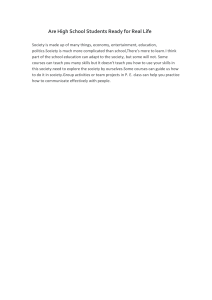
See discussions, stats, and author profiles for this publication at: https://www.researchgate.net/publication/321213965 The Influence of Perceived Organizational Politics on Employee Performance: A Case Study of Lahore, Pakistan Article · January 2017 CITATION READS 1 1,513 3 authors: Arshad Haroon Yasir Hussain Superior University Superior University 5 PUBLICATIONS 6 CITATIONS 1 PUBLICATION 1 CITATION SEE PROFILE Mohsin Nawaz Riphah International University 12 PUBLICATIONS 24 CITATIONS SEE PROFILE Some of the authors of this publication are also working on these related projects: Organizational Politics on Employee Performance View project training and development View project All content following this page was uploaded by Arshad Haroon on 22 November 2017. The user has requested enhancement of the downloaded file. SEE PROFILE American Journal of Social Science Research Vol. 3, No. 3, 2017, pp. 7-11 http://www.aiscience.org/journal/ajssr ISSN: 2381-7712 (Print); ISSN: 2381-7720 (Online) The Influence of Perceived Organizational Politics on Employee Performance: A Case Study of Lahore, Pakistan Arshad Haroon, Yasir Hussain*, Muhammad Mohsin Nawaz College of Accountancy, Superior University, Lahore, Pakistan Abstract The aim of this paper is to examine the impact of perceived organizational politics on employees’ performance in Lahore, Pakistan. For this purpose, previous research literature was critically reviewed regarding perceived organizational politics and employee’s performance and the data was collected through self-administrative questionnaires. 250 questionnaires were distributed among the employees of different private organizations in Lahore, Pakistan and 230 completed questionnaires were received giving us a response rate of 92%. The non-probability convenience sampling technique was used for the selection of data collection. SPSS 20.0 was used in order to study the impact of perceived organizational politics on employees’ performance. Pearson product moment correlation and regression analysis is used. Findings indicated that a negative relationship exists between perceived organization politics and employee’s performance. Keywords Employees Performance, Perceived Organizational Politics, Manufacturing Sector Received: March 31, 2017 / Accepted: May 11, 2017 / Published online: October 17, 2017 @ 2017 The Authors. Published by American Institute of Science. This Open Access article is under the CC BY license. http://creativecommons.org/licenses/by/4.0/ 1. Introduction Organizational politics has long been discussed in organizations and its generally perceived that politics is part of the organizational environment. Similarly, there are many other studies that focused on employees and their relationship to organizations [1]. Consequently, the need for such studies is becoming more and more, as organizations in contemporary era consider employees for generation of the competitive advantage [2]. This paper examined the perception of organizational politics and its possible effect on employees’ performance. Organizations try to remain competitive in contemporary era and many organizations for such purposes try to dictate the level of perception of organizational politics and employees’ performance [3]. According to [4] employees in organizations with politics display a tendency to a negative behavior than those that have lower level of politics. However, to create a synergy between the employees and organization’s goals, politics also play an important role [5]. This study has focused on explaining the effect of perceived organizational politics on employees’ performance. According to [6], workplace authority and control plans are also part of the organization politics. Organizational politics although has been focus of the many studies but recent trend shows that it’s focus is now more on the policy level and strong decision making [7]. According to [8] perception of organizational politics refers to such activity, attitude or behavior by individuals that they use for their self-benefit while having no remorse if that causes problems for others in the organization. Organizational politics not only disrupt the processes in organizations but also negatively impact the performance of employees, prevalence of justice as well as well-being of workers [9]. Employees performance is affected by such * Corresponding author E-mail address: Arshad.haroon@superior.edu.pk (A. Haroon), Yasir.Hussain11@yahoo.com (Y. Hussain), mohsinnawaz204@yahoo.com (M. M. Nawaz) 8 Arshad Haroon et al.: The Influence of Perceived Organizational Politics on Employee Performance: A Case Study of Lahore, Pakistan processes as it shatters the sense of justice in organization and people having more influence and relations with the management tend to avail more benefits at the costs of others [10]. Many studies have tried to answer whether politics have a positive or negative affect or what are its consequences [11, 12, 13] some has also worked on team level [14]. However, there have been no study only about the perception of organizational politics and employees’ performance in the locale of Lahore, Pakistan. In the coming sections, study will discuss literature review on the variables under consideration. Hypothesis was developed after literature review. Methodology explains the study method and findings however at the end of the paper discussion and conclusion were placed. 2. Literature Review 2.1. Perceived Organizational Politics and Employee’s Performance Politics has been defined as a behavior by individuals for betterment of their own self by using fair basis in the organization [15]. According to [8] perception of organizational politics can be described as attaining and promoting the self-interest on oneself by manipulating the working environment and its structure. Individuals engage or at least show behavior of politics that might be better able to explain the organizational politics in organization [16]. Such perception of organizational politics affect many outcomes in the organization such as Job Satisfaction, Job Involvement and Job Anxiety etc. According to [17] political practices becomes a part of the culture of organization whenever there is ambiguity about the job responsibilities or environment of the organization. In a country with more power distance, political activities are more noticeable that might result in [18]. According to [19], countries having power distance restrict employees such that their remuneration and promotion are based on the managers of the organizations. Sometimes policies are developed such that the motive of the managers isn’t to introduce biasness in organization however some employees attain certain options that are not available for others [20]. Although perception of organizational politics is somewhat common in all organizations but its level of engagement varies according to the type of organizations as well, such as retail industry which has to interact to satisfy customers and not their benefits [21] Recent studies have considered perceived organizational politics as a predictor of various organizational outcomes while also considering environment components and employee work outcomes as dependent variables [22, 23]. Different researchers studied the field of political opinions inside the place of work and relative to its nature and it is mostly found that it also affects the working results of organization [24, 25]. Recent research study shows that personality traits of people also play a role in politics engagement and can actually wither reduce or increase the effects of organizational politics on job results of employees [26]. It has also been found that organizational politics negatively affect the job satisfaction of employees. However, at the same time it was also pointed out that job performance of older employees is poor than the younger employees due to a lack of awareness about organizational politics [27] which signifies that organizational politics might also predict better job performance. [23] also checked a link between decision-making policy, obligations of employees and organizational politics with worker absenteeism to explain the nature of politics in the organization. Perceived organizational politics engages a person to attain whatever is beneficial from the higher authority or the management of the company and same procedure lies in the society as well [28]. 2.2. Hypothesis On the basis of the above literature, the following hypothesis was developed: H1: There is an impact of perceived organizational politics on employee performance. 3. Methodology The current study aims to determine the influence of perceived organizational politics on employees’ performance. The research philosophy in this study was positivism and the approach was deductive in nature as the already developed knowledge was being tested. Survey method was used for collection of data from the respondents. Population included all the employees in Lahore Pakistan area that are employed in any organization. Perceived organzitional politics was measured through scale provided by [29] and employee performance scale was adopted from [30]. After satisfactory results of pilot testing and having Cronbach alpha higher than.7 for both instrument, data collection phase was taken place. Data was collected from both the private and public organizations. However, there was no sampling frame provided so the data was collected on convenience of the researchers. The sampling technique used for the study was non-probability convenience sampling. The data which collected through personal survey of different organizations however permission was taken from Top Management. 250 questionnaires were distributed among the employees of different organizations out of which 230 questionnaires were received from the respondents at a response rate of 92%. American Journal of Social Science Research Vol. 3, No. 3, 2017, pp. 7-11 SPSS 20 was used for inferential analysis regarding the predictor and dependent variable. 4. Results and Analysis Category Age Classification (Yrs) 21-30 31-40 41-50 51 and above Marital Status Married Single Windowed Divorced Gender Male Female Total Experience <1 >1-5 >5-10 >10-15 >15-20 >20-25 >25 Frequency 111 90 23 6 91 117 19 3 173 57 13 116 59 33 4 4 1 Percentage (%) 46.25 37.50 9.58 2.50 37.92 48.75 7.92 1.25 72.08 23.75 5.42 48.33 24.58 13.75 1.67 1.67 0.42 Table 1 shows that most of respondents are male (75.2%), single (50.9%) and aged between 20-30 years old (48.3%). It is also observed that the majority of the respondents have >15 experience (50.4). Table 2. Correlations. EP EP OP Pearson Correlation Sig. (2-tailed) Pearson Correlation Sig. (2-tailed) N 1 .323** .001 230 OP Table 3. Model Summary. R Square 1 .323a .150 Adjusted R Square .045 Regression Residual Total Sum of Squares 4.855 93.197 98.052 Df 1 228 229 Mean Square 4.855 .409 F Sig. 11.877 .001b a. Dependent Variable: EP b. Predictors: (Constant), OP Table 4 of ANOVA shows that the value of F is 11.877 (greater than 5) which show the overall fitness of the model however the level of significance P is .001 which is less than.05. So it can also be said that model is highly significant as well. Table 5. Coefficientsa. Unstandardized Coefficients B Std. Error (Constant) 3.007 .234 OP -.224 .065 Model 1 Standardized Coefficients T Sig. Beta 12.865 .000 .223 3.446 .001 a. Dependent Variable: EP In table 5, Constant is 3.007 which is the average value of employee performance when the perception of organizational politics is zero however -.224, which is the value of beta, indicate that one unit change in perception of organizational politics will bring .224 unit decrease in employee performance as the impact is inverse in nature. The impact of the perceived organizational politics on employee’s performance is significant as well (p=.001) 5. Discussion Table 2 shows that correlation values between organization politics and employees performance. 0.323** that shows that both organizational politics and employee performance are weakly correlated and highly significant with each other. R Model 1 **. Correlation is significant at the 0.01 level (2-tailed). Model Table 4. ANOVAa. 1 Table 1. Demographics. 9 Std. Error of the Estimate .63934 a. Predictors: (Constant), OP Table 3 shows that R is 0.323 which clarifies that 32.3% relationship exists between organization politics and employees performance. As the value of R square (coefficient of determination) is .150 which shows that 15% variation exists in employee’s performance due to organization politics. The findings of this study confirm with the findings of [31] that organizational politics diminishes the employee performance because organizational politics increases the job stress of the employee and in the stress, level the employee cannot work at its full potential. [11] also endorsed that perception of organzitional politics had a negative effect on the employees’ performance. Our findings also ensured that same findings of [8] and [13]. Increase in organizational politics or its perception leads to the development of ambiguous environment and culture of the origination. Such conditions generate problems not only for organizations but for employees as well. A political environment creates stress and lack of commitment among the members of the organizations which leads towards the decrease in employees’ performance. 6. Conclusion Organizational politics is one of the commonly practice in the organization. Individual use politicking skills in order to 10 Arshad Haroon et al.: The Influence of Perceived Organizational Politics on Employee Performance: A Case Study of Lahore, Pakistan maximize their self-interest. According to the literature, organizational politics can be constructive or destructive however when the individual goals are synchronized with the organizational goals then it will enhance the employee performance and help the organization in order to create the competitive edge in the market. When the individual goals conflict with the organizational goals then in such case use of politicking skills will produce a non-effective activity for the organization and among the members. This study is helpful to managerial level as they can understand that in presence of politics employees’ performance deteriorate that ultimately affects the level of performance of organization. this study has explained that in Pakistan, politics individually is a negative factor for employees’ performance. 7. Limitation and Future Directions aggressive behavior in organizations. organizational Behavior, 23(5), 571-591. Journal of [8] Kacmar, K. M., & Baron, R. A. (1999). Organizational politics: The state of the field, links to related processes, and an agenda for future research. [9] Chang, C. H., Rosen, C. C., & Levy, P. E. (2009). The relationship between perceptions of organizational politics and employee attitudes, strain, and behavior: A meta-analytic examination. Academy of Management Journal, 52(4), 779801. [10] Forret, M. L. & Dougherty, T. W. (2001). Correlates of networking behavior for managerial and professional employees. Group & Organization Management, 26 (3), 283311. [11] Ferris, G. R., Russ, G. S., & Fandt, P. M. (1989). Politics in organizations n RA Giacalone & P. Rosenfeld (Eds). Impression Management in the Organization. [12] Kacmar, K. M., Collins, B. J., Harris, K. J., & Judge, T. A. (2009). Core self-evaluations and job performance: the role of the perceived work environment. Journal of Applied Psychology, 94(6), 1572. This study has just focused on the impact of perceived organizational politics on employees’ performance however recent studies have tried to consider many other variables such as psychological contract as mediator or moderator. Such inclusion of mediator or moderator might better predict the results more comprehensively and can explain in what conditions politics might explain the negative effect or positive one. Longitudinal or qualitative study can also help for this purpose. Same findings can be replicated on specific sectors while considering other variables. [15] Eisenberger, R., Huntington, R., Hutchison, S., & Sowa, D. (1986). Perceived organizational support. Journal of Applied Psychology, 71(3), 500. References [16] Kacmar, K. M., & Baron, R. A. (1999). Organizational politics: The state of the field, links to related processes, and an agenda for future research. [13] Mintzberg, H. (1985). The organization as political arena. Journal of management studies, 22(2), 133-154. [14] Treadway, D. C., Ferris, G. R., Hochwarter, W., Perrewé, P., Witt, L. A., & Goodman, J. M. (2005). The role of age in the perceptions of politics--job performance relationship: a threestudy constructive replication. Journal of applied psychology, 90(5), 872. [1] Aggarwal, U., & Bhargava, S. (2010). Predictors and outcomes of relational and transactional psychological contract. Psychological Studies, 55(3), 195-207. [17] Gotsis, G. N., & Kortezi, Z. (2010). Ethical considerations in organizational politics: Expanding the perspective. Journal of Business Ethics, 93(4), 497-517. [2] Rastgar, A. A., & Pourebrahimi, N. (2013). Social loafing in banking industry of Iran: Investigating the role of organizational commitment. Asian Journal of Research in Social Sciences and Humanities, 3(5), 1-11. [18] Shao, R., Rupp, D. E., Skarlicki, D. P., & Jones, K. S. (2013). Employee justice across cultures: A meta-analytic review. Journal of Management, 39(1), 263-301. [3] Lee, S. M., Lee, D., & Kang, C. Y. (2012). The impact of high-performance work systems in the health-care industry: employee reactions, service quality, customer satisfaction, and customer loyalty. The Service Industries Journal, 32(1), 1736. [19] Hofstede, G. H., & Hofstede, G. (2001). Culture's consequences: Comparing values, behaviors, institutions and organizations across nations. Sage. [20] Kennedy, J. C. (2002). Leadership in Malaysia: Traditional values, international outlook. [4] Adams, J. S., Tashchian, A., & Shore, T. H. (2001). Codes of ethics as signals for ethical behavior. Journal of Business Ethics, 29(3), 199-211. [21] Dubinsky, A. J., & Levy, M. (1985). Ethics in retailing: Perceptions of retail salespeople. Journal of the Academy of Marketing Science, 13(1), 1-16. [5] Sparrow, P. R., & Gaston, K. (1996). Generic climate maps: a strategic application of climate survey data? Journal of Organizational Behavior, 679-698. [6] Pfeffer, J. (1992). Management with Power, Boston. MA: Harvard Business School Press [22] Rosen, C. C., Levy, P. E., & Hall, R. J. (2006). Placing perceptions of politics in the context of the feedback environment, employee attitudes, and job performance. Journal of Applied Psychology, 91(1), 211-220. [7] Vigoda, E. (2002). Stress‐related aftermaths to workplace politics: the relationships among politics, job distress, and [23] Vigoda-Gadot, E. & Meisler, G. (2010). Emotions in management and the management of emotions: The Impact of Emotional Intelligence and Organizational Politics on Public Sector Employees. Public Administration Review, 70 (1), 72-86. American Journal of Social Science Research Vol. 3, No. 3, 2017, pp. 7-11 11 [24] Goleman, D. (1995). Emotional Intelligence. Bantam Books: New York, NY. [28] Pfeffer, J. (1981). Power in Organizations. London: Pitman Publishing [25] Petrides, K. V. & Furnham, A. (2006). The role of trait emotional intelligence in a gender-specific model of organizational variables. Journal of Applied Social Psychology, 36 (2), 552-569. [29] Kacmar, K. M., & Ferris, G. R. (1991). Perceptions of organizational politics scale (POPS): Development and construct validation. Educational and Psychological measurement, 51(1), 193-205. [26] Hochwarter, W. A. &Treadway, D. C. (2003). The interactive effects of negative and positive affect on the politics perceptions-job satisfaction relationship. Journal of Management, 29 (4), 551-67. [30] Wiedower, K. A. (2002). A shared vision: The relationship of management communication and contingent reinforcement of the corporate vision with job performance, organizational commitment, and intent to leave. [27] Treadway, D. C., Adams, G. L., & Goodman, J. M. (2005). The formation of political sub-climates: Predictions from social identity, structuration, and symbolic interaction. Journal of Business and Psychology, 20(2), 201-209. [31] Enyinna, U. K., Lazarus, O., & Ukpai, K. A. Organizational Politics and Employees’ Performance in Private Sector Investment: A Comparative Study of Zenith Bank Plc and Alcon Plc. Nigeria. View publication stats




